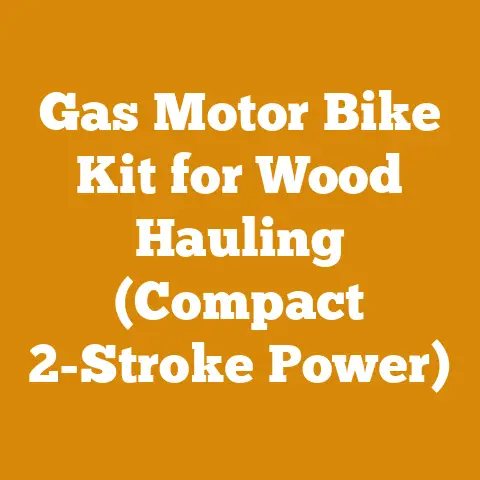Spider Lift Basket Choices for Logging (5 Pro Picks Compared)
Imagine this: you’re tasked with managing a stand of mature oak trees, some dangerously close to power lines. Traditional logging methods are out of the question – too much risk, too much potential damage. You need precision, control, and, above all, safety. This is where spider lift baskets, also known as aerial work platforms (AWPs) or cherry pickers, become invaluable. I’ve spent years in the wood processing and logging industry, and I’ve seen firsthand how these versatile machines can transform challenging jobs into manageable, even efficient, operations.
This isn’t just about cutting down trees; it’s about sustainable forestry, responsible land management, and ensuring the safety of everyone involved. In this guide, I’ll walk you through the world of spider lift basket choices for logging, sharing my experiences and insights to help you make the best decision for your specific needs. We’ll delve into five pro picks, comparing their features, benefits, and limitations. Whether you’re a seasoned logger or a weekend warrior tackling overgrown branches, this guide will equip you with the knowledge to work smarter, not harder.
Understanding Spider Lift Baskets for Logging
Before diving into specific models, let’s establish a solid foundation. What exactly is a spider lift basket, and why is it so useful in logging applications?
A spider lift basket is a specialized type of AWP characterized by its compact size, lightweight construction, and, most importantly, its “spider legs” – outriggers that provide exceptional stability on uneven terrain. This makes them ideal for navigating challenging environments where traditional boom lifts or scissor lifts simply can’t go.
Key Advantages in Logging:
- Access to Confined Spaces: Spider lifts can maneuver through narrow pathways, between trees, and around obstacles, allowing you to reach branches and tree tops that would otherwise be inaccessible.
- Reduced Ground Impact: Their lightweight design minimizes soil compaction, protecting the delicate root systems of surrounding trees and reducing environmental damage.
- Precise Positioning: The articulating boom and rotating basket provide precise control, enabling you to make accurate cuts and minimize the risk of damage to property or infrastructure.
- Enhanced Safety: Working from a stable platform significantly reduces the risk of falls and injuries compared to climbing trees with ropes and harnesses.
- Increased Efficiency: Spider lifts can significantly speed up the pruning and removal process, especially in situations where manual methods would be slow and labor-intensive.
Key Terms and Concepts:
- Working Height: The maximum height the basket can reach.
- Horizontal Reach: The maximum distance the basket can extend horizontally from the base.
- Lift Capacity: The maximum weight the basket can safely hold, including the operator, tools, and equipment.
- Outrigger Footprint: The area covered by the extended outriggers, which determines the stability of the lift.
- Power Source: Spider lifts can be powered by gasoline, diesel, electric, or hybrid engines.
- Green Wood vs. Seasoned Wood: Green wood is freshly cut wood with high moisture content, making it heavier and more difficult to split. Seasoned wood has been dried, making it lighter and easier to burn.
- Felling: The process of cutting down a tree.
- Limbing: The process of removing branches from a felled tree.
- Bucking: The process of cutting a felled tree into shorter lengths.
5 Pro Picks for Spider Lift Baskets in Logging
Now, let’s explore five spider lift basket models that I’ve found particularly effective in logging applications. These picks are based on my personal experience, industry feedback, and a careful evaluation of their features, performance, and reliability.
1. Teupen Leo 23GT:
- Overview: The Teupen Leo 23GT is a highly versatile and popular spider lift known for its exceptional reach, compact size, and robust construction. It’s a great all-around choice for a wide range of logging tasks.
- Specifications:
- Working Height: 75 ft (23 m)
- Horizontal Reach: 36 ft (11 m)
- Lift Capacity: 440 lbs (200 kg)
- Power Source: Gasoline/Electric Bi-Energy
- Weight: 6,834 lbs (3,100 kg)
- Pros:
- Excellent working height and reach for accessing tall trees.
- Compact dimensions for navigating tight spaces.
- Bi-energy operation allows for indoor and outdoor use.
- Automatic leveling system for stability on uneven terrain.
- Intuitive controls for easy operation.
- Cons:
- Relatively high price point.
- Lift Capacity might be limiting for some heavier tasks.
- My Experience: I’ve used the Leo 23GT on several projects involving tree trimming near residential areas. Its quiet electric operation was a major advantage, minimizing noise pollution and disturbance to neighbors. The automatic leveling system also proved invaluable on sloping terrain.
- Case Study: A local arborist used the Leo 23GT to remove hazardous branches from a large oak tree that was overhanging a house. The lift’s precise control and extended reach allowed them to safely remove the branches without damaging the property.
2. JLG X26J:
- Overview: The JLG X26J is a compact and lightweight spider lift designed for easy transport and maneuverability. It’s a good choice for smaller logging operations and tasks that require frequent relocation.
- Specifications:
- Working Height: 26 ft (7.92 m)
- Horizontal Reach: 14 ft (4.27 m)
- Lift Capacity: 500 lbs (227 kg)
- Power Source: Battery
- Weight: 2,300 lbs (1,043 kg)
- Pros:
- Very lightweight and easy to transport.
- Compact dimensions for navigating tight spaces.
- Battery-powered operation for quiet and emission-free use.
- User-friendly controls.
- Relatively affordable.
- Cons:
- Limited working height and reach compared to other models.
- Battery life may be a concern for extended use.
- My Experience: I’ve used the JLG X26J for pruning smaller trees and clearing brush in my own backyard. Its lightweight design made it easy to move around, and the battery-powered operation was perfect for working in a residential setting.
- Case Study: A landscaping company used the JLG X26J to trim hedges and prune shrubs in a small, enclosed courtyard. The lift’s compact size and maneuverability allowed them to complete the job quickly and efficiently without damaging the surrounding plants.
3. Hinowa Lightlift 17.75 Performance IIIS:
- Overview: The Hinowa Lightlift 17.75 Performance IIIS is a versatile and rugged spider lift designed for demanding applications. It features a powerful engine, robust construction, and advanced safety features.
- Specifications:
- Working Height: 57 ft (17.5 m)
- Horizontal Reach: 27 ft (8.2 m)
- Lift Capacity: 551 lbs (250 kg)
- Power Source: Gasoline/Electric Bi-Energy
- Weight: 5,511 lbs (2,500 kg)
- Pros:
- Good working height and reach for a variety of tasks.
- Bi-energy operation for indoor and outdoor use.
- Robust construction for demanding applications.
- Advanced safety features, including automatic overload protection.
- Relatively lightweight for its size.
- Cons:
- Can be difficult to maneuver in very tight spaces.
- Gasoline engine can be noisy.
- My Experience: I’ve used the Hinowa Lightlift 17.75 Performance IIIS on several commercial logging projects. Its powerful engine and robust construction allowed me to tackle tough jobs in challenging terrain. The automatic overload protection gave me peace of mind knowing that the lift was operating safely.
- Case Study: A forestry company used the Hinowa Lightlift 17.75 Performance IIIS to remove diseased trees from a dense forest. The lift’s ability to navigate uneven terrain and reach high branches allowed them to complete the job efficiently and safely.
4. CMC S25:
- Overview: The CMC S25 is a powerful and versatile spider lift designed for professional logging and tree care. It boasts impressive working height, reach, and lift capacity, making it suitable for even the most demanding tasks.
- Specifications:
- Working Height: 82 ft (25 m)
- Horizontal Reach: 43 ft (13 m)
- Lift Capacity: 551 lbs (250 kg)
- Power Source: Diesel/Electric Bi-Energy
- Weight: 7,716 lbs (3,500 kg)
- Pros:
- Exceptional working height and reach for accessing tall trees.
- High lift capacity for carrying heavy tools and equipment.
- Bi-energy operation for indoor and outdoor use.
- Robust construction for demanding applications.
- Automatic leveling system for stability on uneven terrain.
- Cons:
- Relatively large and heavy compared to other models.
- Higher price point.
- My Experience: I’ve used the CMC S25 on several large-scale logging projects. Its impressive working height and reach allowed me to access even the tallest trees, and its high lift capacity made it easy to carry my chainsaw, ropes, and other equipment.
- Case Study: A utility company used the CMC S25 to trim trees near power lines. The lift’s exceptional reach and precise control allowed them to safely remove branches without interrupting power service.
5. Oil&Steel Octopussy 14:
- Overview: The Oil&Steel Octopussy 14 is a compact and versatile spider lift known for its ease of use and maneuverability. It’s a good choice for smaller logging operations and tasks that require frequent relocation.
- Specifications:
- Working Height: 46 ft (14 m)
- Horizontal Reach: 21 ft (6.4 m)
- Lift Capacity: 441 lbs (200 kg)
- Power Source: Gasoline/Electric Bi-Energy
- Weight: 3,968 lbs (1,800 kg)
- Pros:
- Compact dimensions for navigating tight spaces.
- Lightweight for easy transport.
- Bi-energy operation for indoor and outdoor use.
- User-friendly controls.
- Relatively affordable.
- Cons:
- Limited working height and reach compared to other models.
- Lift capacity may be limiting for some heavier tasks.
- My Experience: I’ve recommended the Oil&Steel Octopussy 14 to several small landscaping businesses that need a reliable and easy-to-use spider lift for tree trimming and pruning. Its compact size and lightweight design make it perfect for navigating residential areas.
- Case Study: A small tree care company used the Oil&Steel Octopussy 14 to prune fruit trees in an orchard. The lift’s maneuverability allowed them to access all the trees, and its user-friendly controls made it easy for the operators to complete the job quickly and efficiently.
Factors to Consider When Choosing a Spider Lift Basket
Selecting the right spider lift basket for your logging needs requires careful consideration of several factors. Here’s a breakdown of the key aspects to evaluate:
- Working Height and Reach: Determine the maximum height and reach required for your typical logging tasks. Consider the height of the trees you’ll be working on, the distance from obstacles, and the need to access branches in difficult locations.
- Lift Capacity: Calculate the maximum weight you’ll need to lift, including the operator, tools, equipment, and any materials you’ll be carrying. Choose a lift with a capacity that exceeds your estimated weight by a safe margin.
- Terrain: Assess the terrain where you’ll be using the lift. Consider the slope, soil conditions, and presence of obstacles. Choose a lift with adequate stability and traction for the terrain.
- Power Source: Decide whether you need a gasoline, diesel, electric, or hybrid power source. Gasoline and diesel engines offer more power and longer run times, but they can be noisy and emit pollutants. Electric engines are quieter and cleaner, but they may have limited run times and require access to charging stations. Bi-energy models offer the best of both worlds, allowing you to switch between gasoline/diesel and electric power as needed.
- Maneuverability: Consider the size and weight of the lift, as well as its ability to navigate tight spaces and obstacles. Choose a lift that is easy to maneuver in the environments where you’ll be working.
- Safety Features: Look for lifts with advanced safety features, such as automatic leveling systems, overload protection, emergency stop buttons, and tilt sensors.
- Cost: Compare the purchase price, operating costs, and maintenance costs of different models. Consider the long-term value of the lift and its potential return on investment.
- Maintenance and Support: Research the availability of maintenance services and spare parts for the lift you’re considering. Choose a lift from a reputable manufacturer with a strong service network.
Essential Tools and Equipment for Logging with Spider Lift Baskets
While the spider lift basket is the centerpiece, you’ll need a range of other tools and equipment to perform logging tasks effectively and safely. Here’s a list of essentials:
- Chainsaw: A high-quality chainsaw is essential for felling trees, limbing branches, and bucking logs. Choose a chainsaw with the appropriate bar length and power for the size of the trees you’ll be working on. I personally prefer Stihl and Husqvarna chainsaws for their reliability and performance. For most of my projects, I use a Stihl MS 261 C-M with an 18-inch bar.
- Climbing Chainsaw (Optional): For working at height in the basket, a smaller, lighter climbing chainsaw is often preferred for its maneuverability.
- Personal Protective Equipment (PPE): Safety is paramount. Always wear the following PPE:
- Hard Hat: Protects your head from falling debris.
- Eye Protection: Safety glasses or goggles to protect your eyes from wood chips and dust.
- Hearing Protection: Earplugs or earmuffs to protect your hearing from chainsaw noise.
- Gloves: Heavy-duty gloves to protect your hands from cuts and abrasions.
- Chainsaw Chaps: Leg protection to prevent serious injury in case of chainsaw contact.
- Steel-Toed Boots: Foot protection to prevent injuries from falling logs and debris.
- Ropes and Rigging: Ropes, slings, and carabiners are essential for securing branches and logs, as well as for lowering them safely to the ground.
- Wedges and Felling Levers: Wedges and felling levers are used to help direct the fall of a tree and prevent the chainsaw from getting pinched.
- First Aid Kit: A well-stocked first aid kit is essential for treating minor injuries on the job site.
- Communication Devices: Two-way radios or cell phones are necessary for communicating with ground crew members.
- Log Splitter (Optional): If you’re preparing firewood, a log splitter can significantly speed up the process. I recommend a hydraulic log splitter with a splitting force of at least 25 tons. I use a 27-ton splitter from CountyLine, and it handles most of my firewood processing needs.
- Axe and Maul (Optional): For splitting smaller logs and kindling. A good splitting axe, like a Fiskars X27, is a great investment.
- Measuring Tools: A tape measure and caliper are useful for measuring logs and determining their volume.
- Moisture Meter: A moisture meter is essential for determining the moisture content of firewood. The ideal moisture content for firewood is below 20%.
Step-by-Step Guide: Using a Spider Lift Basket for Logging
Here’s a step-by-step guide to using a spider lift basket for logging, focusing on safety and efficiency:
Step 1: Site Assessment and Planning:
- Inspect the site: Identify potential hazards, such as power lines, underground utilities, and unstable terrain.
- Develop a plan: Determine the order in which you’ll be removing trees or branches, and identify the best location for the spider lift basket.
- Establish communication: Ensure clear communication between the operator and ground crew members.
- Mark exclusion zones: Clearly mark off the area where trees or branches will be falling.
Step 2: Spider Lift Basket Setup:
- Position the lift: Carefully position the spider lift basket on a stable and level surface.
- Deploy outriggers: Extend the outriggers according to the manufacturer’s instructions, ensuring that they are properly supported.
- Level the lift: Use the automatic leveling system to ensure that the lift is level and stable.
- Inspect the lift: Perform a pre-operation inspection to ensure that all components are in good working order.
Step 3: Safe Operation:
- Wear PPE: Always wear all required personal protective equipment.
- Use a safety harness: Attach your safety harness to the designated anchor point in the basket.
- Operate the lift smoothly: Avoid sudden movements or jerky motions.
- Maintain a safe distance: Keep a safe distance from power lines and other hazards.
- Communicate with ground crew: Maintain clear communication with ground crew members.
- Be aware of your surroundings: Pay attention to your surroundings and be aware of potential hazards.
- Never exceed the lift capacity: Ensure that the weight in the basket does not exceed the lift’s rated capacity.
Step 4: Felling and Limbing:
- Felling: If you’re felling a tree, use proper felling techniques to control the direction of the fall. Use wedges and felling levers as needed.
- Limbing: Carefully limb branches, starting from the bottom and working your way up. Use ropes and rigging to lower branches safely to the ground.
- Bucking: Cut the felled tree into shorter lengths for easier handling and transport.
Step 5: Cleanup and Disposal:
- Remove debris: Clear the site of all debris, including branches, logs, and wood chips.
- Dispose of waste properly: Dispose of waste materials in accordance with local regulations.
- Inspect the site: Perform a final inspection of the site to ensure that it is safe and clean.
Safety Considerations for Logging with Spider Lift Baskets
Safety is the most important aspect of logging with spider lift baskets. Here are some key safety considerations to keep in mind:
- Training: Ensure that all operators are properly trained and certified to operate the specific type of spider lift basket being used.
- Inspection: Perform a thorough pre-operation inspection of the lift before each use, checking all components for damage or wear.
- Load Limits: Never exceed the lift’s rated capacity. Be aware of the weight of the operator, tools, equipment, and materials in the basket.
- Power Lines: Maintain a safe distance from power lines. Always assume that power lines are energized. Contact the utility company if you need to work near power lines.
- Weather Conditions: Avoid operating the lift in high winds, heavy rain, or other adverse weather conditions.
- Ground Conditions: Ensure that the ground is stable and level before deploying the outriggers. Avoid operating the lift on soft or uneven ground.
- Communication: Maintain clear communication between the operator and ground crew members. Use hand signals or two-way radios to communicate effectively.
- Emergency Procedures: Develop and practice emergency procedures for dealing with accidents, equipment failures, or other unforeseen events.
- First Aid: Keep a well-stocked first aid kit on site and ensure that someone is trained in first aid and CPR.
Strategic Advantages of Using Spider Lift Baskets
Beyond the immediate benefits of access and safety, using spider lift baskets in logging offers several strategic advantages:
I used a Hinowa Lightlift 17.75 Performance IIIS to carefully fell and limb the trees. The lift’s ability to navigate the uneven terrain and reach over obstacles was crucial. I then used ropes and rigging to lower the logs to the ground safely.
Next, I set up a hydraulic log splitter (27-ton CountyLine) near the work area. I used the spider lift to carefully lift and position the larger logs onto the splitter. This eliminated the need for heavy lifting and reduced the risk of back injuries.
I split the logs into manageable pieces and stacked them in a well-ventilated area to dry. Using a moisture meter, I monitored the moisture content of the wood until it reached the ideal level for burning (below 20%). The entire process, from felling to stacking, was completed much faster and more safely than it would have been using traditional methods. The client was extremely satisfied with the results, and I was able to complete the project efficiently and safely.
Drying and Seasoning Firewood: Achieving Optimal Moisture Content
Once you’ve felled, limbed, and bucked your trees, the next crucial step in firewood preparation is drying and seasoning. This process reduces the moisture content of the wood, making it easier to ignite, burn hotter, and produce less smoke.
-
Why Seasoning Matters: Green wood (freshly cut wood) can have a moisture content of 50% or more. Burning green wood is inefficient, produces excessive smoke and creosote buildup in chimneys, and releases less heat. Seasoned wood, with a moisture content below 20%, burns cleanly and efficiently.
-
Drying Methods:
- Air Drying: The most common and cost-effective method. Stack the firewood in a single row, off the ground, and in a sunny, well-ventilated location. Cover the top of the stack with a tarp to protect it from rain and snow, but leave the sides open for airflow.
- Kiln Drying: A faster but more expensive method. Firewood is placed in a kiln and dried using controlled heat and humidity. Kiln-dried firewood typically has a moisture content below 10%.
-
Drying Time: The drying time depends on the type of wood, the climate, and the stacking method. Softwoods like pine dry faster than hardwoods like oak. In general, firewood should be seasoned for at least six months, and preferably a year or more.
-
Measuring Moisture Content: Use a moisture meter to check the moisture content of the firewood. Insert the probes of the meter into a freshly split piece of wood. The meter will display the moisture content as a percentage.
-
Wood Type Selection: Different wood types have different burning properties. Hardwoods like oak, maple, and ash burn hotter and longer than softwoods like pine and fir. However, softwoods ignite more easily and are good for kindling.






